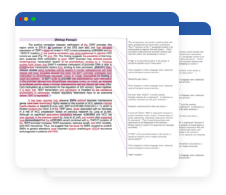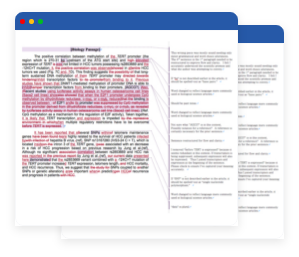How to Use Commas (,)
The comma is a key element of English mechanics. It is used to divide different parts of a sentence. When used properly, commas make writing clear and readable, preventing ambiguous meaning and creating natural flow. Unfortunately, many writers neglect correct comma usage. This easy-to-understand guide will explain when and how to use commas in your writing.
When to use commas
| Incorrect | Correct | |
|---|---|---|
| To connect two independent clauses with an appropriate conjunction |
The apple is red the orange is green. |
The apple is red, and the orange is green. |
| To block off a nonrestrictive clause |
The apple which is red is for the teacher. |
The apple, which is red, is for the teacher. |
| To set off an introductory word or phrase |
In the afternoon we are going to pick apples. |
In the afternoon, we are going to pick apples. |
| To list multiple items |
He likes apples oranges and pears. |
He likes apples, oranges, and pears. |
How to Use Commas in Your Writing
Using Commas to Connect Clauses
Connecting clauses is one of the primary functions of a comma. Using a comma not only enforces natural flow but can also clarify which part of the sentence is being modified.
Independent clauses vs. dependent clauses
An independent clause contains a subject and verb pairing and expresses a complete thought. In other words, an independent clause can function on its own as a full sentence. See the following examples.
- The apple is red.
- Apples grow on trees.
- Susan has picked an apple.
A dependent clause, on the other hand, contains a subject and verb pairing but does not express a complete thought. A dependent clause is not a complete sentence.
- when it is ripe
- although not all fruits grow on trees
- because it looked delicious
Dependent marker words turn independent clauses into dependent clauses.
- It is ripe. → when it is ripe
- Not all fruits grow on trees. → although not all fruits grow on trees
- It looked delicious. → because it looked delicious
Common dependent marker words : because, despite, if, before, although, though, before, after, since, as, unless, until, when, whenever, whether, while
Run-on sentences and comma splices
A run-on sentence occurs when two independent clauses are not properly separated or connected. There are three different ways of separating or connecting two independent clauses.
-
With a period
Since an independent clause is a complete sentence, you can separate two independent clauses with just a period.
- Clause 1
- The apple is red.
- Clause 2
- It is for the teacher.
- Combined
- The apple is red. It is for the teacher.
-
With a comma in combination with a conjunction
Commas can be used in combination with a conjunction. When using a conjunction, it is important to choose the conjunction that is most appropriate for the context.
Common conjunctions: and, or, but, so, yet, for
- Clause 1
- Apples grow on trees.
- Clause 2
- Not all fruits grow on trees.
- Combined
- Apples grow on trees, but not all fruits grow on trees.
-
With a semicolon (or colon – depending on how the clauses are related)
Semicolons are used to connect two independent clauses that are closely related with one another.
- Clause 1
- Susan likes reading.
- Clause 2
- She has been reading since she was two.
- Combined
-
Susan likes reading; she has been reading since she was two.
Colons can be used in a similar matter but only if the content of the two clauses are closely related in such a way that the second clause defines the first.
- Clause 1
- The orange was a favorite of Portuguese sailors.
- Clause 2
- The fruit is high in vitamin C, which is effective for preventing scurvy.
- Combined
- The orange was a favorite of Portuguese sailors: the fruit is high in vitamin C, which is effective for preventing scurvy.
And there are three incorrect ways of connecting two independent clauses:
-
With no punctuation
The most obviously incorrect way of connecting two independent clauses is just putting them together without any punctuation or conjunction.
- Incorrect
- Apples grow on trees not all fruits grow on trees.
-
With only a comma
A comma on its own is not sufficient to properly connect two independent clauses. This error is called a comma splice.
- Incorrect
- Apples grow on trees, not all fruits grow on trees.
-
With only a conjunction
A conjunction on its own is not sufficient to properly connect two independent clauses.
- Incorrect
- Apples grow on trees but not all fruits grow on trees.
To combine independent clauses, use another punctuation mark such as a period or semicolon. or use a comma followed by a conjunction.
- Correct
- Apples grow on trees. Not all fruits grow on trees.
- Correct
- Apples grow on trees, but not all fruits grow on trees.
Subject, Verb, and Object Rules
Commas cannot be inserted anywhere in a given sentence. Most notably, a comma should not (1) separate a subject and its verb or (2) separate a verb and its object.
Do not: separate a subject and its verb
Many writers assume that commas should simply be placed where a speaker would pause. And in spoken English, people occasionally do pause between a subject and its verb. However, in written English, placing a comma between a subject and its verb interrupts the natural flow of the sentence.
- Incorrect
- Susan’s roommate Rosa, planted an apple tree.
- Correct
- Susan’s roommate Rosa planted an apple tree.
Do not: separate a verb and its object
A comma should not separate a transitive verb from its direct object. Like the case above, this is another error that may be difficult to spot intuitively. Separating a verb from its object impedes readability and makes a sentence seem unnatural.
- Incorrect
- Susan said, her roommate planted a tree.
- Correct
- Susan said her roommate planted a tree.
Restrictive and Nonrestrictive Clauses
When using commas, it’s crucial to know the difference between types of clauses. The most important difference is that of independent and dependent clauses. However, it is also important to be able to distinguish between restrictive and nonrestrictive clauses.
Restrictive vs. nonrestrictive clauses – What is the difference?
The key difference of restrictive and nonrestrictive clauses has to do with the necessity of information. Restrictive clauses provide essential information about a noun or noun phrase. Nonrestrictive clauses, on the other hand, provide supplementary information about a noun or noun phrase.
- Example
-
The essay that Jane wrote is five pages long.
Here, “that Jane wrote” is a restrictive clause because without it, it would be unclear which essay is five pages long. The fact that Jane wrote this essay is essential information.
- Example
-
Jane’s essay, which is five pages long, got an A.
Here, “which is five pages long” is a nonrestrictive clause. The primary point of this sentence is that Jane’s essay got an A. The length of Jane’s essay is supplementary information.
Do not: use commas to block off restrictive clauses
Restrictive clauses should not be set off by commas.
- (a)
- The girl who sits in the front asks a lot of questions.
- (b)
- The girl, who sits in the front, asks a lot of questions.
Which sentence is correct: (a) or (b)? First, it is necessary to identify whether “who sits in the front” is a restrictive or nonrestrictive clause. Without the clause “who sits in the front,” it would be unclear which girl asks a lot of questions. Therefore, “who sits in the front” is a restrictive clause, and the correct sentence is (a).
Do: use commas to block off nonrestrictive clauses
Nonrestrictive clauses should be set off by commas.
- (a)
- My friend Amy who sits in the front asks a lot of questions.
- (b)
- My friend Amy, who sits in the front, asks a lot of questions.
Which sentence is correct: (a) or (b)? Again, it is necessary to first identify whether “who sits in the front” is a restrictive or nonrestrictive clause. The primary point is that Amy asks a lot of questions. The fact that she sits in the front is supplementary information. Therefore, “who sits in the front” is a nonrestrictive clause, and the correct sentence is (b).
Commas After Introductory Elements
Every introductory element should be followed by a comma. This helps clarify where the introductory element ends and the main part of the sentence begins.
- (a)
- After eating lunch with his friends, Peter went to the library.
- (b)
- After eating lunch with his friends Peter went to the library.
Comparing (a) and (b), it is clear that (a) is more readable. This is because eliminating the comma following the introductory element – “after eating lunch with his friends” – makes it difficult to perceive the location of the subject “Peter.”
The Oxford Comma
The Oxford or serial comma is typically considered optional (although it either should or should not be used consistently throughout a given work). However, its use is standard in American English as well as mandated by certain style guides. Furthermore, there are cases in which the Oxford comma is necessary to prevent ambiguity.
- Example
- Lana wrote letters to her parents, Leia and Michael.
This sentence can be interpreted in two ways: (1) Leia and Michael are the names of her parents, or (2) Lana wrote letters to her parents and two other people named Leia and Michael. Placing a comma after “Leia” would make it clear that Leia and Michael are two other people and not the names of her parents.
E.g. and I.e.
The rules for using a comma after e.g. and i.e. vary across style guides. However, in American English, it is standard to always follow both e.g. and i.e. with a comma.
- Incorrect
- There are many tropical fruits, e.g. mangos, coconuts, and bananas.
- Correct
- There are many tropical fruits, e.g., mangos, coconuts, and bananas.










